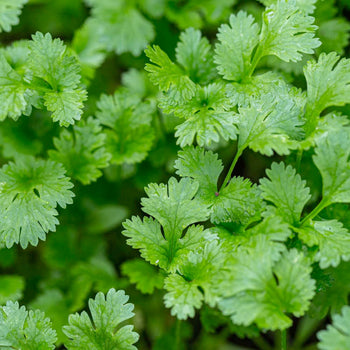
Season: Fall - Spring
Looking for a Specific Herb?
Search Our Herb Almanac Below:
|
|
|
Coriander (Coriandrum sativum) is an annual herb in the family Apiaceae. It is also known as dhania or cilantro. All parts of the plant are edible, but the fresh leaves and the dried seeds (which are both a herb and a spice) are the parts most traditionally used in cooking.
Most people perceive coriander as having a tart, lemon/lime taste, but to nearly a quarter of those surveyed, the leaves taste like dish soap, linked to a gene that detects some specific aldehydes that can produce soapy sensation from the odorant substances.
|
 |

Mature Height
24 Inches |
 |

Mature Width
12 Inches |
 |

Light
Sun |
 |

Water
Moderate |
 |
|
Uses
Fresh leaves and dried seeds are the most commonly used in cooking, but all parts of the plant are edible, and the roots are an important element of Thai cooking. Coriander is used in cuisines throughout the world.
The leaves are variously referred to as coriander leaves, fresh coriander, Chinese parsley, or (in the US and commercially in Canada) cilantro. The fresh leaves are an ingredient in many foods, such as chutneys and salads, salsa, guacamole, and as a widely used garnish for soup, fish, and meat. As heat diminishes their flavor, coriander leaves are often used raw or added to the dish immediately before serving. In Indian and Central Asian recipes, coriander leaves are used in large amounts and cooked until the flavor diminishes. The leaves spoil quickly when removed from the plant and lose their aroma when dried or frozen.
The taste of the leaves and the seeds are distinct. The seeds exhibit citrus overtones. The dominant flavorings in the leaves are the aldehydes 2-decenal and 2-dodecenal. The main flavoring in the seeds is linalool.
|
 |
|
RECIPES
Cilantro Lime Chicken
PREP: 10 MINUTES COOK: 15-20 MINUTES
ADDITIONAL TIME: 30 MINUTES
INGREDIENTS
2 Tbsp Olive Oil
4 Garlic Cloves, Minced
½ Tsp Cumin
½ Tsp Salt
1 Tsp Black Pepper
1 Lime, Zest & Juice
1 Lime, Cut into Wedges
1 Bunch of Cilantro, Roughly Chopped
6 Boneless, Skinless Chicken Thighs
INSTRUCTIONS
1. Combine olive oil, minced garlic, cumin, salt, and pepper in a small bowl.
2. Zest lime. Juice lime. Roughly chop the cilantro. Add lime zest, lime juice, and half of the chopped cilantro to the bowl. Stir to combine into marinade.
3. Place chicken thighs in a shallow dish. Add the marinade and toss the chicken to coat. Allow the chicken to marinate for 30 minutes or up to 8 hours (refrigerated), flipping it once as it marinates.
|
|




















